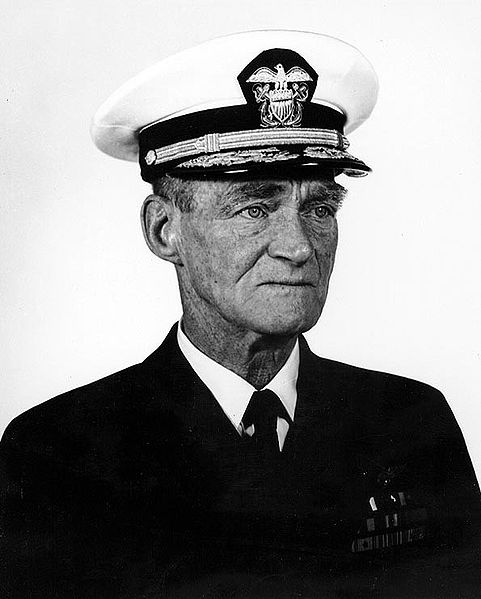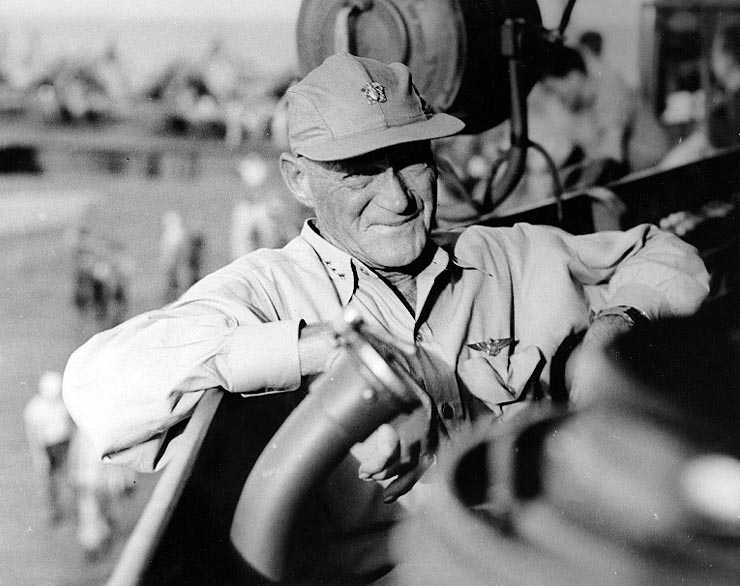<Back to Index>
- Physicist Polykarp Kusch, 1911
- Writer José María Valverde Pacheco, 1926
- Admiral of the U.S. Navy Marc Andrew "Pete" Mitscher, 1887
PAGE SPONSOR


Admiral Marc Andrew "Pete" Mitscher (January 26, 1887 – February 3, 1947) was a vice - admiral in the United States Navy who served as commander of the Fast Carrier Task Force in the Pacific in the latter half of World War II.
Marc Andrew "Pete" Mitscher was born in Hillsboro, Wisconsin, on January 26, 1887, the son of Oscar & Myrta (Shear) Mitscher. Mitscher's grandfather Andreas Mitscher (1821 – 1905) was a German immigrant from Traben - Trarbach. In 1854 Andreas married Constantina Moln who was also of German descent. During the western land boom of 1889, when Marc was two years old, his family resettled in Oklahoma City, Oklahoma, where his father, a federal Indian Agent, later became that city's second mayor. Despite the family settlement in Oklahoma, records attest that Mitscher attended elementary and secondary schools in Washington, D.C. and received an appointment to the U.S. Naval Academy at Annapolis, Maryland in 1904 through Bird Segle McGuire, then U.S. Representative from Oklahoma. An indifferent student, Mitscher seemed to be in continuous trouble, earning 159 demerits in one class year. In 1906 he resigned, but his father immediately coaxed McGuire to reappoint him. After six years, in 1910 he graduated 113th out of 131 classmates and served at sea for two years (as required by law at that time) on board USS Colorado (ACR-7), becoming a commissioned Ensign on March 7, 1912. In August 1913 he served aboard the USS California (ACR-6) on the West Coast of the U.S. during the Mexican Campaign
Subsequent to duties on the destroyers USS Whipple (DD-15) and USS Stewart (DD-13), in September 1915 Mitscher reported for aviation training at Naval Aeronautic Station, Pensacola, Florida, on board the armored cruiser USS North Carolina (ACR-12), at that time one of the first ships in the U.S. Navy to carry an airplane. Mitscher was designated Naval Aviator No. 33 on June 2, 1916. Almost a year later, on April 6, 1917, he reported to the renamed armored cruiser USS Huntington (ACR-5) previously commissioned USS West Virginia (ACR-5), for duty in connection with aircraft catapult experiments. This duty was followed by command of NAS Dinner Key in Coconut Grove, Florida, by Lt. Mitscher. Dinner
Key was the second largest naval air facility in the U.S. and was used
to train seaplane pilots. On July 18, 1918 he was promoted to Lt.
Commander and in February 1919 he transferred from NAS Dinner Key to
the Aviation Section in the Office of the Chief of Naval Operations before reporting to Seaplane Division 1. On May 10, 1919 he took off from Newfoundland as the pilot of the NC-1, one of four Curtiss NC Flying Boat aircraft in the Naval Transatlantic flight expedition. His plane and the NC-3 landed in heavy fog near the Azores, but heavy seas prevented them from joining NC-4 in completing the first transatlantic air passage. For his part in this historic operation, Mitscher received the Navy Cross. The citation for his Navy Cross read as follows: "For
distinguished service in the line of his profession as a member of the
crew of the Seaplane NC-1, which made a long overseas flight from New
Foundland to the vicinity of the Azores, in May 1919". In addition to several shore based commands, Mitscher, during the next two decades, served on the aircraft carriers Langley and Saratoga, the seaplane tender Wright, and as the Commander of Patrol Wing 1. Lieut.
Marc A. Mitscher reported for duty aboard USS Aroostook (CM-3) on
October 14, 1919, serving under the Commanding Officer Captain Henry C.
Mustin. USS Aroostook was assigned temporary duties as flag ship for
the Air Detachment, Pacific Fleet. He was promoted to Lieut. Comdr.
date of rank July 1, 1921. In May 1922, Lieut. Comdr. Mitscher was
detached from Air Squadrons, Pacific Fleet (San Diego CA) to command
Naval Air Station Anacostia, D.C.
Between June 1939 and July 1941 he served as assistant chief of the
Bureau of Aeronautics. Thereafter, he fitted out the carrier Hornet, and he assumed her command at her commissioning in October 1941. While under his command, the Hornet launched the Doolittle Raid against Japan in early 1942 and thus gained fame as to their point of origin being "Shangri La" expressed during a news conference given by President Roosevelt. Mitscher
captained her during the Battle of Midway 4 to June 6, but his air
group's performance in that crucial engagement ranged from
disappointing to outright disastrous. On the eve of the Battle of
Midway, Admiral Mitscher, with the support of his Air Group Commander,
CDR Stanhope C. Ring, denied fighter air cover to the Hornet's torpedo
squadron, led by LCDR John C. Waldron. Mitscher then ordered the strike
group to fly a course of 265 degrees true (instead of the 234 degrees
of the enemies last sighting). This resulted in most of the airgroup
never sighting the enemy. Only Waldron's Torpedo Eight squadron,
because Waldron disobeyed orders and flew course 240 degrees, flew
directly to the enemy carrier group's location. Torpedo Eight was the
first carrier squadron to be in position to attack. Unescorted by
fighters, Torpedo Eight was decimated by Japanese Zeros. Only one man
survived (Ens. George H.Gay Jr). However, Torpedo Eight's sacrifice
enabled dive bombers from the carriers Enterprise and Yorktown to sink
three Japanese carriers virtually unopposed. In spite of CDR Ring's
hearing CDR Waldron's radioed report that he had found the enemy, CDR
Ring continued on course 260 degrees to nowhere. The Hornet strike
force following the orders of CDR Ring was unable to find the enemy,
and eventually headed back toward either the Hornet, or Midway Island,
to land and refuel. All ten fighters in the formation ran out of fuel
and ditched at sea. Several dive bombers also had to ditch on their
approach to the Midway base. Except for Torpedo Eight, none of the
Hornet's strike force played any role on the first day of the Battle of
Midway. Mitscher was detached from the Hornet June 30, less than four months before her loss on October 26 during the Battle of the Santa Cruz Islands. Mitscher commanded Patrol Wing 2 until December when he became commander fleet air, Nouméa. In April 1943 he became commander air, Solomon Islands,
and from August to January 1944 he commanded Fleet Air, West Coast.
Returning to the central Pacific as Commander, Carrier Division 3, he
was appointed Vice Admiral March 21, 1944 and ordered to take command of the Fast Carrier Task Force (then 5th Fleet's TF 58). With the Lexington as his flagship for this task force, which operated alternately as 3rd Fleet's TF 38, he inflicted severe and irreparable damage on Japanese
ground installations and against enemy naval and merchant shipping. His
hard hitting, wide ranging carriers pounded the enemy from Truk to the Palaus, along the New Guinea coast, and throughout the Marianas. His eager, resourceful aviators devastated Japanese carrier forces in the Battle of the Philippine Sea
— also
known as the Marianas Turkey Shoot — during June 1944. Notably, when a
follow-up strike was forced to return to his carriers in darkness,
Mitscher earned the gratitude of his pilots by turning on the flight
decks' running lights, defying standard naval procedure and ensuring
that most of them were recovered. During the next year his warring carriers spearheaded the thrust against the heart of the Japanese Empire, covering successively the invasion of the Palaus, the liberation of the Philippines, and the conquest of Iwo Jima and Okinawa. During these operations he repeatedly led the fast carriers northward to pound the Japanese home islands. By
July 1946 when he returned to the United States to serve as Deputy
Chief of Naval Operations (Air), Mitscher had received, among other
awards, two Gold Stars in lieu of a second and third Navy Cross and the Distinguished Service Medal with two Gold Stars. He served briefly as commander 8th Fleet and on March 1, 1946 became Commander - in - Chief, U.S. Atlantic Fleet, with the rank of Admiral. While serving in that capacity, Mitscher died at Norfolk, Virginia, at the age of 60. He was buried in Arlington National Cemetery. Two ships of the Navy have been named USS Mitscher in his honor; the post - World War II frigate, USS Mitscher (DL-2) later re-designated as the guided missile destroyer (DDG-35), and the currently serving Arleigh Burke - class guided missile destroyer, USS Mitscher (DDG-57). In addition to the ships named after Admiral Mitscher, the airfield and a street at Marine Corps Air Station Miramar (Naval Air Station Miramar) have been named in his honor (Mitscher Field and Mitscher Way).
The words of Admiral
Arleigh Burke provide the greatest tribute and recognition of his leadership: